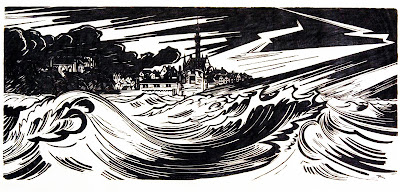 Finding a bunch
of old sketchbook drawings in a local car boot by Dutch landscape and cow
painter Gerrit Stegeman (1858-1940) unexpectedly lead to a semi-academic exercise
in Internet exploring and research.
Finding a bunch
of old sketchbook drawings in a local car boot by Dutch landscape and cow
painter Gerrit Stegeman (1858-1940) unexpectedly lead to a semi-academic exercise
in Internet exploring and research.
 Preparing
and training undergraduate students investigating the origin of statements,
“facts” and quotations is the accepted way learning how to write
academically reliable papers and theses later. Following the footsteps of history and
footnotes of publications the library and, in modern days, the Internet is their
excavation field.
Preparing
and training undergraduate students investigating the origin of statements,
“facts” and quotations is the accepted way learning how to write
academically reliable papers and theses later. Following the footsteps of history and
footnotes of publications the library and, in modern days, the Internet is their
excavation field.
In their
wake I decided to follow this exercise in the case of Stegemans wonderful sketch
of a pissing cow. Stegeman, a schoolmaster’s son, born and raised in the
country probably just sketched “a pissing cow”. But unknowingly revived and followed in the footsteps of the Great Masters from two centuries before. Living in rural
and dairy country Friesland, pissing cattle are of course an everyday sight but maybe not necessarily so for modern city dwellers. So, let's go out and tour around a bit.
The source of this theme, tracing the first (my investigations not reaching as far back as the Romans
who had less of a problem with the calls of nature) may have been Paulus Potter’s (1625-1654) pissing cow. His famous original
copied, mirrored and immitated many times by many artists. Most of them engravers/etchers, and their work often wrongly attributed.
Another
probable original source could be Nicolaes Pietersz. Berchem (1620-1683) an equally
famous painter and etcher of cattle and contemporary of Potter. Most of their work
is now in the collections of the Rijksmuseum in Amsterdam. Including the pissing sheep and goats by
Berchem. With Potter and Karel Dujardin (1625-1678) they were the great Italian style Dutch landscape artists of the 17th century.
Just "mouse-click" and see the often incredible details in these miniature gems.
 Just before,
in 1619, the iconic statue of Menneken Pis by Hieronymus Duquesnoy was created in
commission of the city council of Brussels after an earlier 14th century example. Since
a decade or two it has a little sister: Jenneken Pis.
Just before,
in 1619, the iconic statue of Menneken Pis by Hieronymus Duquesnoy was created in
commission of the city council of Brussels after an earlier 14th century example. Since
a decade or two it has a little sister: Jenneken Pis.
About the same time in Italy Guido Reni (1575-1642) painted his pissing wine drinking cherub with much humor: notice the leaking wine barrel.

Probably
the earliest example besides this statue of a Roman farting actor from the 1th century AD I found was the squatting peasant (below) by Jacques
Callot (1592-1635).
Adriaen van
Ostade (1610-1685) was an original too, and like Potters bovine equivalent had many later
followers and copiers of his burlesque pissing drinker. Like Bernhard Scheuder (1748-1780) and the one attributed to the circle of van Ostade (below)
Rembrandt
(1606-1669), always trying something new, showed his fascination for the ordinary and the basic human
needs by showing old and young and both sexes in natural poses. He did them probably later in
life.
I guess they
were both popular and controversial in their days. But maybe they are considered even more controversial in ours. They are hardly seen or discussed.
Pissing horses: if you've ever seen a horse watering you know were the saying comes from. No wonder artists were drawn showing them. Very powerfull and imaginative stuff. I found a good many, these a selection. Typical: almost if not all shown are male horses in contrast to the female cows, yews and goats.
Jan van Aken (1614-1661)
Jan Peeter Verdussen (1700-1763) and Dirk Langendijk (1748-1805)
Pedro Nunez de Villavincenzio (1640-1710) made one of the few(?) oil paintings showing pissing cattle I could
find:
Arthur
Boris Klein (1893-1985) as a Russian in Paris became world famous for his hilarious, instantly and insanely popular etchings of Paris' pissing dogs in the 1960’s. Still (or again?) affordable and very
collectable. They even hang in my old mothers hall way drawing smiles from every visitor even in 2012.
 Thomas
Bewick’s (1753-1828) example of a pissing dog: nonchalant and sketched to the life. 200 years old and actual and fresh like a 2012 comic cartoon.
Thomas
Bewick’s (1753-1828) example of a pissing dog: nonchalant and sketched to the life. 200 years old and actual and fresh like a 2012 comic cartoon.
And the youngest
example, although "hors concours" I found was so hilarious I couldn’t possibly withhold. All you need is a pencil and
two dead flies. Plus a creative mind a dull moment and a somewhat different sense of humor.
Well, speaking
of humor: if I offended you in any way with this posting's pictures (how did you get as far as this I might ask) please keep in mind father and son Brueghel, Pieter the elder (1525-1569)
and Pieter the younger
(1564-1636), both saw the humorous side of pissing. Their pissing at the moon making me smile even after 450 years !
See an update of this posting (june 3th) here *

























.jpg)








.jpg)





+Peasant+Squatting+1617+m.jpg)








.jpg)
.jpg)




